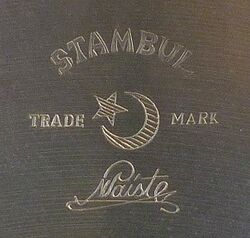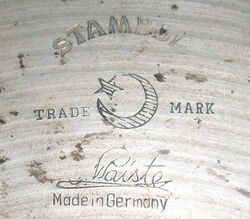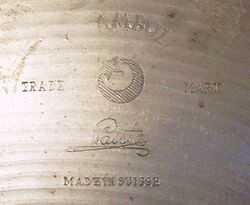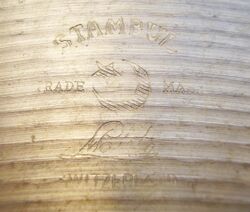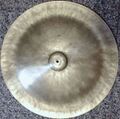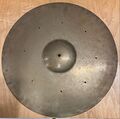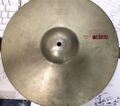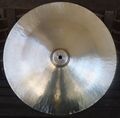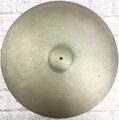Paiste Stambul
Stambul NS12
Contents
Introduction: 1930's?*
Discontinued: 1970 (NS12 version) 1978 (B8 version) See B8 Stambuls for '71 and later history
Background: Introduction 1930's / Discontinued 1970 (NS12 version) 1978 (B8 version), transitioned into the 505 series) see B8 Stambuls for '71 and later history
As far as the dating and where these cymbals were made, the following provides a basic timeline *(we do not have any documentation that precedes the early 1950's):
1932-1940 (Estonia)
1940-1945 (Poland)--relocation during WWII, small production
1945-1948 (Germany)--relocation after WWII, small production
1948-1957 (Germany)--expanded production once again
1957-1977 (Switzerland & Germany)
The Stambul line was considered Paiste's top-of-the-line cymbal prior to the Formula 602 release in 1959, where it took a second place position after that.
Dating and identifying Stambuls, like other cymbals of this time frame are a real challenge, as there are only a few means to physically evaluate a time period. We have provided a few indicators to help narrow down date ranges.
Indicator #1 Alloy Type: NS12-Nickel Silver was used from 1930's through 1970 (B8 came into play in 1965 and was then utilized on virtually of the lower line cymbals by 1970/71).
Indicator #2 Mounting Hole Size: Most cymbal stands started to be changed/made stronger by 1957 or 1958, as many drum companies started this trend with their hardware. Todays mounting holes are 1/2" diameter, but previous sizes ranged from 7/16" to 3/8" diameter. This indicates that the cymbal was made most likely prior to 1960.
Indicator #3 Distinctively Larger Bell: Stambuls had a much larger bell than what is now a common size (see pics below). This is shown in the 1950 and 1952 catalogs, we aren't exactly sure when the downsizing of the bell took place, it's possible that smaller bells transitioned in with the new release of the Stambul 65's in 1965 or earlier.
Indicator #4 Colored Ink Labels: ? - 1959: Red "size" in inches followed by the "type/weight" ink stamp at 3 o'clock. Mid 60's - 1973: Red ink diameter/size stamp under the bell until 1973 (or very late '72) and then it changes to Black for the reminder of Black Label phase (1973-1981). 1971: "Paiste" name ink stamp now gets applied above the bell, this included other series, not just Stambul. 1972: Series name ink stamp below Paiste name.
Indicator #5 Location Name: We believe this can be helpful as an indicator because if the logo had No location shown, it was either an earlier model (pre-1957) or one used later towards the end of the production runs (1970-1975). There were 2-3 different location names used for those cymbals made in Switzerland. Germany used "made in Germany". The following show the variations for Swiss made:
"Swiss Made" this is believed to be the first one used out of the factory (1957 to 1958)
"Made in Suisse" we've only seen one of these, but assume this was probably another early run (1957 to 1958)
"Switzerland" this was utilized through much of the remaining years (1959 to early 1970's)
As far as the embossed Stambul logo, we are fortunate that the overall logo style did not change much over the entire life of the Stambul (see logos to the right). It's design uses a large size, hollow block letters with 1 or 2 thin vertical lines through each letter spelling out "Stambul". But, this name was all set on a curve or arc form above the logo components. Below this was the Star and Crescent pattern that was tilted so that the star was in the 10-O'clock position with varying cross-hatchings through its interior. The words, 'Trade' and 'Mark' were set to the outside of this logo: "Trade" on the left of it, and "Mark" on the right. Underneath this was the signature "Paiste" name, it was actually shown with part of a lower-case "m" at the "P" location, representing Mikhail M. Paiste.
- Note: There is one occasion where there is no signature under the logo. Instead, Paiste used the "Robert Paiste" name in a typical type font. And, after 1957, most Stambuls had a Location name under the signature.
- Note: Robert Paiste took ownership of the company in 1957, so this was likely that Paiste had a dedication to him by using his full name on this cymbal. This seemed to only occur at or after he took control of the company, so likely from '57 to '59.
Provided below is a quick dating chart until further information is found:
Early 1950's ('52):
- NS12, small (7/16") mounting hole, and 'possibly' (5 or 6) cross-hatchings in the star and (13 or 14) in the crescent, and No location identified. Additionally, the 'Trade' and 'Mark' are spaced farther away from the logo work during this time frame.
Pre-1956:
- Small (7/16") mounting hole, NS12, No location under Paiste signature, No ink stamps, star cross-hatching (7 or 8) and crescent has (13 or 14). Some say "Foreign Made", as well.
1957 to 1958:
- NS12, location says "Swiss Made", star cross-hatchings (10 or 11) and crescent has (17 or 18).
1958 or 1959 to ?:
- NS12, location says "Switzerland" and lists "Robert Paiste" above, star cross-hatching (9 to 11) and crescent has (17 or 18).
Late 1960's & early 1970's:
- B8 or NS12, star cross-hatching (5 or 6) and crescent has (13 or 14), various locations (Switzerland, Germany or no location), and ink labels present.
Post 1970 and transition into the 505:
- See the B8 Stambul page for '71 and later history
- B8 version, star cross-hatching (7 or 8) and crescent has (13 or 14), some have "Paiste Stambul" in the black ink stamp. End of series run show ink labels saying "Paiste 505" in black at 12-O'clock position under embossed logo. It is speculated that Paiste was just trying to rid themselves of excess Stambul inventory at this time.
As far as Stambul models, weights and sizes, this is what the research has shown (see catalog pictures below):
1950 CATALOG: (all cymbals were made up to 20" in size, there was a special order option for 22")
Concert & Marching (Turkish-style) Medium & Heavy: 12" through 20"
Marching (Chinese-style) Medium with raised edges: 10" through 20"
Hi Hats of 2 types for "Charleston" cymbals (as they were called then): Flat 10" through 14" (strong 'chick' sound) Thin & Medium
Up or High: 9" through 14" (rattling sound) Thin & Medium
Be-Bop (Strange hollow tone/deep, full sound) Thin & Medium: 10" through 13"
Swish cymbals (particular sharp tone) Thin & Medium: 11" through 14"
'Zisch' cymbals (Hiss or hissing beautiful sound) Paperthin & Thin: 10" through 14"
'Gong' cymbals (Strong, full sound) Medium & Heavy: 11" through 20"
1952 CATALOG: (this catalog was expanded and it offered a universal list for help in ordering)
Hi hats (11"-16")
Hiss Paperthin's or Swish Thins: 10"-14"
Thins (13"-14"), and Thin or Medium: 16"-20"
Jazz (Types: Zisch, Swish, Be-Bop and Gong) Paperthin, Thin & Medium: 10" through 20"
Concert & Marching (Turkish-style in pairs) Medium & Heavy: 14" through 20"
Marching (Chinese-style in pairs): 14" through 20"
1965-1969 Paiste (Swiss) CATALOG: (all were made in Thin, Medium or Heavy)
Jazz, Hi-hat, Marching & Concert: 10" through 20", 22", 24" and 26"
Marching (China-type in pairs): 15" through 20"
1968 CATALOG--TRIXON DRUMS:
10" through 20", 22" and 24"
1970 PRICE LIST (European):
Thin, Medium & Heavy: 10" through 20", 22", 24" & 26"
Marching: 14" through 16"
Concert: 17" through 20"
Hi Hats: 13" through 16"
Chinese-style: 15" & 16" Marching china's in pairs, 17" through 20" Concert china's in pairs
Information from: Paiste 1965 catalog Todd Little
Return to the Paiste Series Portal
Return to the Paiste Cymbal Type Portal

